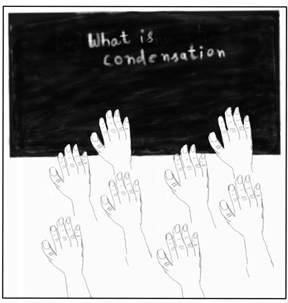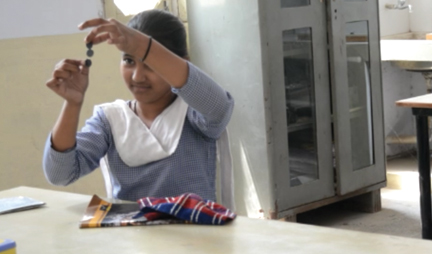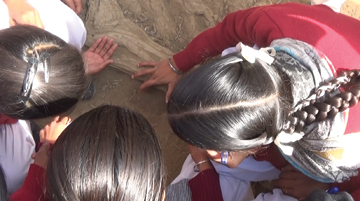Gurinder Singh
Science is about raising questions, answering those questions and more importantly, about questioning existing answers. Not only science but any kind of learning and knowledge acquisition/creation involves asking questions. We all ask questions in our day-to-day lives to understand the world around us and to solve problems. For example, at the bus stop, we may ask other people, which bus will go to the railway station; seeing large crowds or police on the road we may ask ourselves what the matter is; when preparing food, we may ask how much water is needed for cooking dal and after how many whistles the dal will be ready, etc.
Like adults, children also ask questions and younger children ask many more. Children are curious and they always have questions to ask, but as they grow older they learn not to ask questions. At home, sometimes children are scolded for asking too many questions or for asking ‘irrelevant’ questions. In classrooms, they are asked questions and trained to answer and memorize the answers.
Actually, we highly underestimate children by telling them everything and making them listen to us. Research studies have found that compared to adults, children are actually more creative and thoughtful (Vint, 2005).
Students must be engaged in activities and discussions in which they ask their own questions and share ideas and thoughts with each other. Education is a social process that requires much more than individual, isolated students listening and writing.
Though there is widespread recognition of the importance of student questions in education and learning, several reports and studies from classrooms have found that students ask far fewer questions than teachers, with teachers unaware of this being the case (Singh, 2019). Even the nature of teacher questioning is such that it restricts student engagement to that of a passive respondent. To understand all these issues, we need to first understand what is happening inside the classrooms with regard to student and teacher questioning.
Understanding student questioning in classrooms
To understand student questioning, we need to first understand why students ask questions and why their questions are important.
While interacting with teachers, on several occasions, we have asked them about the importance of students’ questions and why students ask questions. Here are some responses given by the teachers:
• To gain knowledge.
• Out of curiosity.
• To clear doubts.
• To apply the acquired knowledge in daily life.
• For fun, to check whether the teacher knows.
• Students sometimes ask to confuse the teacher.
• They ask to get the attention, to be heard.
• Student questioning also helps the teacher to assess whether and how much the student has understood.

Some of these reasons describe the nature of the teacher-student relationship in the classroom, whereby the teacher is more knowledgeable (thus an authority) and responsible for providing the ‘right’ answers. However, at times, this status is challenged by the students. Perhaps the expectation that teachers should provide all the answers needs to change.
Student questions are also important as students will feel more motivated and interested in discussions and inquiries if they are based on their own questions. But even if we understand the importance of student questioning, why is it not more common? When we asked teachers, they said that students do not ask questions because:
• Of language barriers.
• They are unable to frame questions.
• They are afraid to ask as they feel their question is not good.
• They are afraid other students might laugh at them.
• Classrooms are not conducive for asking questions.
• Large class sizes.
• Time constraints, pressure of completing the syllabus.
It’s important that in our classrooms we create an environment where students feel free to talk. Let us consider a few questions here. In classrooms are we providing enough opportunities for students to talk and ask questions? Are we listening to our students? Are we as teachers talking too much and asking too many questions? Do our questions encourage students to think and ask their own questions?
However, there are also systemic issues that impact student engagement and which are beyond the control of the teacher. For such issues we should demand governments to ensure better facilities, resources, better student-teacher ratios, lesser pressure of completing syllabus and more autonomy to the teachers in deciding the curriculum, syllabus and ways of assessment.
Furthermore, the process of asking a question is quite complicated for students as compared to teachers. A student may have a question, but to ask, he/she has to take permission from the teacher, by explicitly asking the teacher, raising a hand, looking at the teacher, or by waiting to be asked. In some rare cases students might ask a question without taking permission or even by interrupting the teacher.
However, teachers do not need any permission to ask a question and they may even interrupt students. So the process of asking is different for a student and a teacher.
Understanding teacher questioning in classrooms
Why do teachers ask questions? Teachers told us they ask questions:
• To know that the topic is understood by the students.
• To know how much the child knows and to check their previous knowledge.
• To check what students have learned.
• To motivate students.
• To let students do some hypothesis formation or make predictions.
• To make students attentive.
• To manage/discipline the class.
So the reasons for a teacher to ask questions are more pedagogical (for the purpose of teaching), whereas the reasons for students to ask are more epistemological (acquiring new knowledge).

Furthermore, in a classroom, the teacher questioning process has a very common pattern. In this pattern the teacher Initiates a discussion by asking a question to the student. In turn, the student answers by Responding to the teacher’s question. After which, the teacher gives Evaluation or feedback on whether the answer is accepted or is right or wrong. This pattern of teacher-student talk is called the IRE talk. Here is an example of such a talk.
Teacher: When area increases, pressure?
Student: Decreases.
Teacher: Decreases. Similarly, tell me the relation between energy and work?
Teacher: When energy will increase, what will increase?
Student: Work will increase
Teacher: Correct …
In IRE talk, the teacher has the control to initiate and terminate talk sequences. This reduces the opportunities for students to ask their own questions or initiate discussions which they might be interested in.
Here is another example:
Teacher: At what temperature water boils?
Student: 98.6 degree Celsius.
Teacher: Wrong
Instead of evaluating, the teacher could have asked the other students whether 98.6 is the right or wrong answer. So an alternate approach could have been,
Teacher: At what temperature water boils?
Student: 98.6 degrees Celsius
Teacher: Ok, how many of you think 98.6 is correct and how many think it is wrong?
Maybe at this point the teacher could have made groups of students to discuss, argue, give reasons, find evidence, or do some activity to find out why the answer is correct or incorrect.
Even if teachers follow the IRE pattern, it helps if they take a longer pause after asking their questions, so more responses can come from students, leading to further discussions. Also, it helps if the teacher pauses before evaluating so that other students might pitch in to the student’s response.
It’s not just the process but also the kind of teacher questioning that impacts the student engagement in the classroom. Generally, we ask closed questions to students that have some expected or fixed answers (mostly known to the teacher). Let us take an example,
Teacher: From where do we get sugar?
Students: Sugarcane.
Now there could be several answers to this question as sugar can be obtained from many different sources and those answers can lead to interesting discussions. However, with students trying to guess the expected answer, their participation becomes passive and they only tend to memorize what is being expected.
Sometimes students are even punished for giving the ‘wrong’ answers, whereas those answers could be a good resource for understanding student thinking. Most assessments and exams are also based on fixed-answer type questions. We seldom ask our students open-ended questions – questions whose answers are not priorly fixed or known and may have multiple right answers. Rather than being memory-based, or requiring rote learning, open-ended questions require more active thinking and analysis. Open-ended questions are more inclusive as more students can participate and answer using their everyday experiences. Here are some examples of closed and open-ended questions:
Name the two poles of a magnet. (closed)
If you are not given a magnet’s poles, how will you find out its two poles? (open-ended)
For the first question, students only need to remember the names of the poles to answer it. However, for second question, students have to think and come up with a procedure as well as answers. Students can be given magnets to find an answer by actually trying out their own ways of finding the poles.
Here is another example:
Name the process by which steam changes into water? (closed)
Give two examples from your daily life where you might have observed condensation of water. (open)
Textbook questions are generally closed and poor for student engagement. We can change them into open-ended questions or we can ask our own open-ended questions to help students think actively and ask questions.
How to encourage student questioning
Apart from what we have already talked about here, what else can we do to encourage student questioning? Let students observe something and talk, argue and discuss in groups.

Here is an example. Let us say we ask our students to observe a pen carefully and share their observations and questions in smaller groups. While observing and engaging in discussions, many interesting questions may emerge. When we tried this activity with teachers, they asked very interesting and novel questions:
• Which kinds of pens write faster and smoother?
• How does the material on which we write impact the pen and writing?
• How has the pen changed with changes in the material on which we write?
• Are there inkless pens? How do they work?
• Which kind of ink does not fade easily and can be read even after hundreds of years?
• Why are the prices of different pens different? What makes them costlier or cheaper?
When looking at something as simple as a pen can lead to adults asking interesting questions, maybe what is needed is to let students observe some material, fiddle and play with it for some time, talk, discuss and argue with each other in groups. They will definitely come up with many interesting questions.
Students can even be taken outdoors to observe trees, plants, birds, insects, etc.
The important thing is that the teacher is open to listening and understanding students’ questions and their ideas.
How to respond when students start asking?
When asked what to do when students are asking questions, most teachers had the opinion that they must answer all the questions. This notion that teachers should provide all answers needs to change. There will be many questions that teachers cannot answer. Such questions can be taken up for inquiry by the students and the teacher together.
Here are some ideas on what we can do once students start asking questions:
• Let students discuss and investigate the questions in smaller groups and do an inquiry on their own. Here, the teacher can guide them in planning and carrying out the inquiry and drawing a conclusion from the inquiry.
• Teacher can also participate in the inquiry along with the students.
• Teacher can help students to look into different resources, books, articles, etc., to gather more information.
Sometimes we may not get an answer but getting involved in discussions and inquiry will make us learn more about the question and raise newer questions and that’s what learning is all about!
References
• Singh, G. (2019). Student Questioning in Student Talk: Understanding the process and its role in doing science [PhD Thesis, Tata Institute of Fundamental Research, Mumbai]. https://tinyurl.com/4zncfemf
• Vint, L. (2005). Fresh thinking drives creativity innovation. Quick, 94, 20-22.
The author is a science educator and science education researcher, currently working in the field of school education with an NGO. He can be reached at gurinderphysics@gmail.com.
